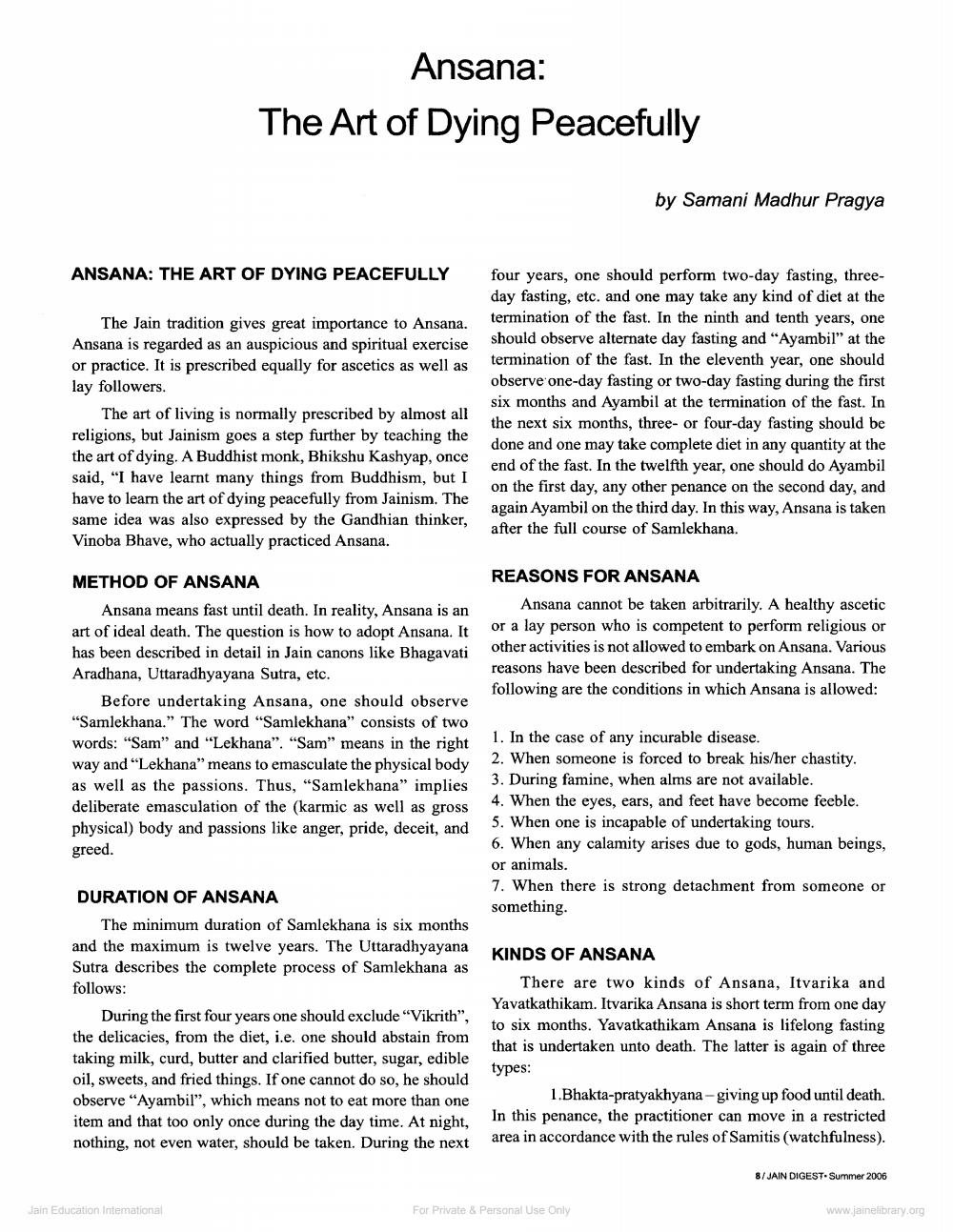________________
Ansana:
The Art of Dying Peacefully
ANSANA: THE ART OF DYING PEACEFULLY
The Jain tradition gives great importance to Ansana. Ansana is regarded as an auspicious and spiritual exercise or practice. It is prescribed equally for ascetics as well as lay followers.
The art of living is normally prescribed by almost all religions, but Jainism goes a step further by teaching the the art of dying. A Buddhist monk, Bhikshu Kashyap, once said, "I have learnt many things from Buddhism, but I have to learn the art of dying peacefully from Jainism. The same idea was also expressed by the Gandhian thinker, Vinoba Bhave, who actually practiced Ansana.
METHOD OF ANSANA
Ansana means fast until death. In reality, Ansana is an art of ideal death. The question is how to adopt Ansana. It has been described in detail in Jain canons like Bhagavati Aradhana, Uttaradhyayana Sutra, etc.
Before undertaking Ansana, one should observe "Samlekhana." The word "Samlekhana" consists of two words: "Sam" and "Lekhana". "Sam" means in the right way and "Lekhana" means to emasculate the physical body as well as the passions. Thus, "Samlekhana" implies deliberate emasculation of the (karmic as well as gross physical) body and passions like anger, pride, deceit, and greed.
DURATION OF ANSANA
The minimum duration of Samlekhana is six months
and the maximum is twelve years. The Uttaradhyayana Sutra describes the complete process of Samlekhana as follows:
During the first four years one should exclude "Vikrith", the delicacies, from the diet, i.e. one should abstain from taking milk, curd, butter and clarified butter, sugar, edible oil, sweets, and fried things. If one cannot do so, he should observe "Ayambil", which means not to eat more than one item and that too only once during the day time. At night, nothing, not even water, should be taken. During the next
Jain Education International
by Samani Madhur Pragya
four years, one should perform two-day fasting, threeday fasting, etc. and one may take any kind of diet at the termination of the fast. In the ninth and tenth years, one should observe alternate day fasting and "Ayambil" at the termination of the fast. In the eleventh year, one should observe one-day fasting or two-day fasting during the first six months and Ayambil at the termination of the fast. In the next six months, three- or four-day fasting should be done and one may take complete diet in any quantity at the end of the fast. In the twelfth year, one should do Ayambil on the first day, any other penance on the second day, and after the full course of Samlekhana. again Ayambil on the third day. In this way, Ansana is taken
REASONS FOR ANSANA
Ansana cannot be taken arbitrarily. A healthy ascetic or a lay person who is competent to perform religious or other activities is not allowed to embark on Ansana. Various reasons have been described for undertaking Ansana. The following are the conditions in which Ansana is allowed:
1. In the case of any incurable disease.
2. When someone is forced to break his/her chastity. 3. During famine, when alms are not available.
4. When the eyes, ears, and feet have become feeble. 5. When one is incapable of undertaking tours.
6. When any calamity arises due to gods, human beings, or animals.
7. When there is strong detachment from someone or something.
KINDS OF ANSANA
There are two kinds of Ansana, Itvarika and Yavatkathikam. Itvarika Ansana is short term from one day to six months. Yavatkathikam Ansana is lifelong fasting that is undertaken unto death. The latter is again of three types:
1.Bhakta-pratyakhyana-giving up food until death. In this penance, the practitioner can move in a restricted area in accordance with the rules of Samitis (watchfulness).
For Private & Personal Use Only
8/JAIN DIGEST Summer 2006
www.jainelibrary.org




